Soshi Iba
Honda Research Institute USA
Diffusing Trajectory Optimization Problems for Recovery During Multi-Finger Manipulation
Oct 08, 2025Abstract:Multi-fingered hands are emerging as powerful platforms for performing fine manipulation tasks, including tool use. However, environmental perturbations or execution errors can impede task performance, motivating the use of recovery behaviors that enable normal task execution to resume. In this work, we take advantage of recent advances in diffusion models to construct a framework that autonomously identifies when recovery is necessary and optimizes contact-rich trajectories to recover. We use a diffusion model trained on the task to estimate when states are not conducive to task execution, framed as an out-of-distribution detection problem. We then use diffusion sampling to project these states in-distribution and use trajectory optimization to plan contact-rich recovery trajectories. We also propose a novel diffusion-based approach that distills this process to efficiently diffuse the full parameterization, including constraints, goal state, and initialization, of the recovery trajectory optimization problem, saving time during online execution. We compare our method to a reinforcement learning baseline and other methods that do not explicitly plan contact interactions, including on a hardware screwdriver-turning task where we show that recovering using our method improves task performance by 96% and that ours is the only method evaluated that can attempt recovery without causing catastrophic task failure. Videos can be found at https://dtourrecovery.github.io/.
GeoDEx: A Unified Geometric Framework for Tactile Dexterous and Extrinsic Manipulation under Force Uncertainty
May 01, 2025Abstract:Sense of touch that allows robots to detect contact and measure interaction forces enables them to perform challenging tasks such as grasping fragile objects or using tools. Tactile sensors in theory can equip the robots with such capabilities. However, accuracy of the measured forces is not on a par with those of the force sensors due to the potential calibration challenges and noise. This has limited the values these sensors can offer in manipulation applications that require force control. In this paper, we introduce GeoDEx, a unified estimation, planning, and control framework using geometric primitives such as plane, cone and ellipsoid, which enables dexterous as well as extrinsic manipulation in the presence of uncertain force readings. Through various experimental results, we show that while relying on direct inaccurate and noisy force readings from tactile sensors results in unstable or failed manipulation, our method enables successful grasping and extrinsic manipulation of different objects. Additionally, compared to directly running optimization using SOCP (Second Order Cone Programming), planning and force estimation using our framework achieves a 14x speed-up.
Diffusion-Informed Probabilistic Contact Search for Multi-Finger Manipulation
Oct 01, 2024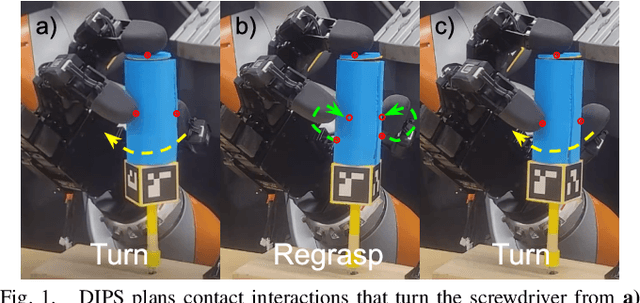

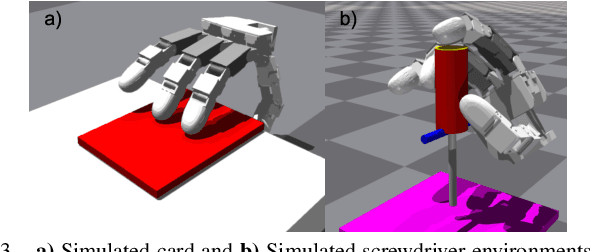
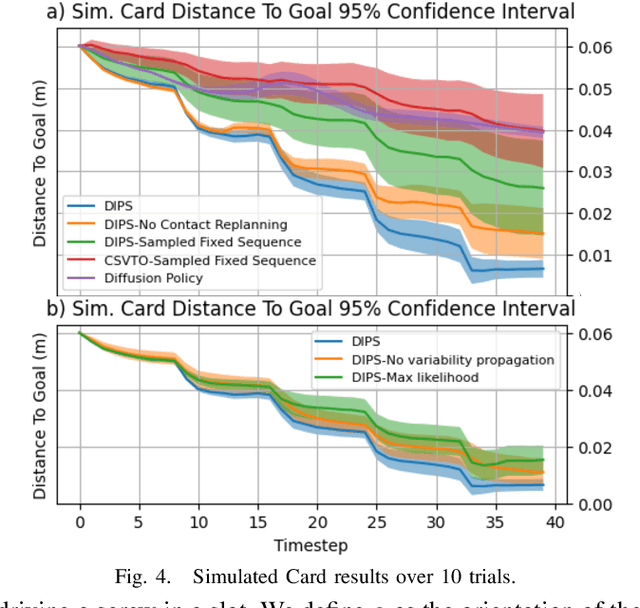
Abstract:Planning contact-rich interactions for multi-finger manipulation is challenging due to the high-dimensionality and hybrid nature of dynamics. Recent advances in data-driven methods have shown promise, but are sensitive to the quality of training data. Combining learning with classical methods like trajectory optimization and search adds additional structure to the problem and domain knowledge in the form of constraints, which can lead to outperforming the data on which models are trained. We present Diffusion-Informed Probabilistic Contact Search (DIPS), which uses an A* search to plan a sequence of contact modes informed by a diffusion model. We train the diffusion model on a dataset of demonstrations consisting of contact modes and trajectories generated by a trajectory optimizer given those modes. In addition, we use a particle filter-inspired method to reason about variability in diffusion sampling arising from model error, estimating likelihoods of trajectories using a learned discriminator. We show that our method outperforms ablations that do not reason about variability and can plan contact sequences that outperform those found in training data across multiple tasks. We evaluate on simulated tabletop card sliding and screwdriver turning tasks, as well as the screwdriver task in hardware to show that our combined learning and planning approach transfers to the real world.
ResPilot: Teleoperated Finger Gaiting via Gaussian Process Residual Learning
Sep 13, 2024Abstract:Dexterous robot hand teleoperation allows for long-range transfer of human manipulation expertise, and could simultaneously provide a way for humans to teach these skills to robots. However, current methods struggle to reproduce the functional workspace of the human hand, often limiting them to simple grasping tasks. We present a novel method for finger-gaited manipulation with multi-fingered robot hands. Our method provides the operator enhanced flexibility in making contacts by expanding the reachable workspace of the robot hand through residual Gaussian Process learning. We also assist the operator in maintaining stable contacts with the object by allowing them to constrain fingertips of the hand to move in concert. Extensive quantitative evaluations show that our method significantly increases the reachable workspace of the robot hand and enables the completion of novel dexterous finger gaiting tasks. Project website: http://respilot-hri.github.io
Multi-finger Manipulation via Trajectory Optimization with Differentiable Rolling and Geometric Constraints
Aug 23, 2024Abstract:Parameterizing finger rolling and finger-object contacts in a differentiable manner is important for formulating dexterous manipulation as a trajectory optimization problem. In contrast to previous methods which often assume simplified geometries of the robot and object or do not explicitly model finger rolling, we propose a method to further extend the capabilities of dexterous manipulation by accounting for non-trivial geometries of both the robot and the object. By integrating the object's Signed Distance Field (SDF) with a sampling method, our method estimates contact and rolling-related variables and includes those in a trajectory optimization framework. This formulation naturally allows for the emergence of finger-rolling behaviors, enabling the robot to locally adjust the contact points. Our method is tested in a peg alignment task and a screwdriver turning task, where it outperforms the baselines in terms of achieving desired object configurations and avoiding dropping the object. We also successfully apply our method to a real-world screwdriver turning task, demonstrating its robustness to the sim2real gap.
HyperTaxel: Hyper-Resolution for Taxel-Based Tactile Signals Through Contrastive Learning
Aug 15, 2024Abstract:To achieve dexterity comparable to that of humans, robots must intelligently process tactile sensor data. Taxel-based tactile signals often have low spatial-resolution, with non-standardized representations. In this paper, we propose a novel framework, HyperTaxel, for learning a geometrically-informed representation of taxel-based tactile signals to address challenges associated with their spatial resolution. We use this representation and a contrastive learning objective to encode and map sparse low-resolution taxel signals to high-resolution contact surfaces. To address the uncertainty inherent in these signals, we leverage joint probability distributions across multiple simultaneous contacts to improve taxel hyper-resolution. We evaluate our representation by comparing it with two baselines and present results that suggest our representation outperforms the baselines. Furthermore, we present qualitative results that demonstrate the learned representation captures the geometric features of the contact surface, such as flatness, curvature, and edges, and generalizes across different objects and sensor configurations. Moreover, we present results that suggest our representation improves the performance of various downstream tasks, such as surface classification, 6D in-hand pose estimation, and sim-to-real transfer.
Hierarchical Deep Learning for Intention Estimation of Teleoperation Manipulation in Assembly Tasks
Mar 28, 2024



Abstract:In human-robot collaboration, shared control presents an opportunity to teleoperate robotic manipulation to improve the efficiency of manufacturing and assembly processes. Robots are expected to assist in executing the user's intentions. To this end, robust and prompt intention estimation is needed, relying on behavioral observations. The framework presents an intention estimation technique at hierarchical levels i.e., low-level actions and high-level tasks, by incorporating multi-scale hierarchical information in neural networks. Technically, we employ hierarchical dependency loss to boost overall accuracy. Furthermore, we propose a multi-window method that assigns proper hierarchical prediction windows of input data. An analysis of the predictive power with various inputs demonstrates the predominance of the deep hierarchical model in the sense of prediction accuracy and early intention identification. We implement the algorithm on a virtual reality (VR) setup to teleoperate robotic hands in a simulation with various assembly tasks to show the effectiveness of online estimation.
ViHOPE: Visuotactile In-Hand Object 6D Pose Estimation with Shape Completion
Sep 11, 2023Abstract:In this letter, we introduce ViHOPE, a novel framework for estimating the 6D pose of an in-hand object using visuotactile perception. Our key insight is that the accuracy of the 6D object pose estimate can be improved by explicitly completing the shape of the object. To this end, we introduce a novel visuotactile shape completion module that uses a conditional Generative Adversarial Network to complete the shape of an in-hand object based on volumetric representation. This approach improves over prior works that directly regress visuotactile observations to a 6D pose. By explicitly completing the shape of the in-hand object and jointly optimizing the shape completion and pose estimation tasks, we improve the accuracy of the 6D object pose estimate. We train and test our model on a synthetic dataset and compare it with the state-of-the-art. In the visuotactile shape completion task, we outperform the state-of-the-art by 265% using the Intersection of Union metric and achieve 88% lower Chamfer Distance. In the visuotactile pose estimation task, we present results that suggest our framework reduces position and angular errors by 35% and 64%, respectively. Furthermore, we ablate our framework to confirm the gain on the 6D object pose estimate from explicitly completing the shape. Ultimately, we show that our framework produces models that are robust to sim-to-real transfer on a real-world robot platform.
Hierarchical Graph Neural Networks for Proprioceptive 6D Pose Estimation of In-hand Objects
Jun 28, 2023



Abstract:Robotic manipulation, in particular in-hand object manipulation, often requires an accurate estimate of the object's 6D pose. To improve the accuracy of the estimated pose, state-of-the-art approaches in 6D object pose estimation use observational data from one or more modalities, e.g., RGB images, depth, and tactile readings. However, existing approaches make limited use of the underlying geometric structure of the object captured by these modalities, thereby, increasing their reliance on visual features. This results in poor performance when presented with objects that lack such visual features or when visual features are simply occluded. Furthermore, current approaches do not take advantage of the proprioceptive information embedded in the position of the fingers. To address these limitations, in this paper: (1) we introduce a hierarchical graph neural network architecture for combining multimodal (vision and touch) data that allows for a geometrically informed 6D object pose estimation, (2) we introduce a hierarchical message passing operation that flows the information within and across modalities to learn a graph-based object representation, and (3) we introduce a method that accounts for the proprioceptive information for in-hand object representation. We evaluate our model on a diverse subset of objects from the YCB Object and Model Set, and show that our method substantially outperforms existing state-of-the-art work in accuracy and robustness to occlusion. We also deploy our proposed framework on a real robot and qualitatively demonstrate successful transfer to real settings.
Deep Tactile Experience: Estimating Tactile Sensor Output from Depth Sensor Data
Oct 17, 2021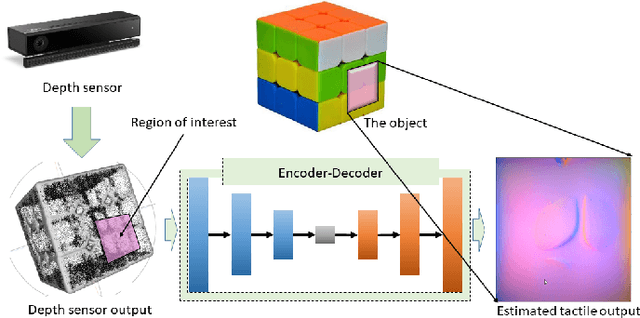
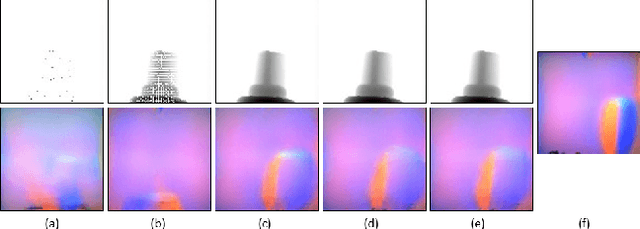
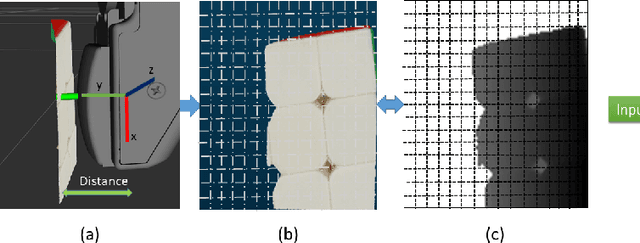
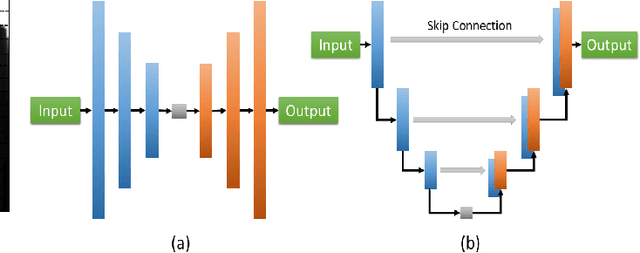
Abstract:Tactile sensing is inherently contact based. To use tactile data, robots need to make contact with the surface of an object. This is inefficient in applications where an agent needs to make a decision between multiple alternatives that depend the physical properties of the contact location. We propose a method to get tactile data in a non-invasive manner. The proposed method estimates the output of a tactile sensor from the depth data of the surface of the object based on past experiences. An experience dataset is built by allowing the robot to interact with various objects, collecting tactile data and the corresponding object surface depth data. We use the experience dataset to train a neural network to estimate the tactile output from depth data alone. We use GelSight tactile sensors, an image-based sensor, to generate images that capture detailed surface features at the contact location. We train a network with a dataset containing 578 tactile-image to depthmap correspondences. Given a depth-map of the surface of an object, the network outputs an estimate of the response of the tactile sensor, should it make a contact with the object. We evaluate the method with structural similarity index matrix (SSIM), a similarity metric between two images commonly used in image processing community. We present experimental results that show the proposed method outperforms a baseline that uses random images with statistical significance getting an SSIM score of 0.84 +/- 0.0056 and 0.80 +/- 0.0036, respectively.
 Add to Chrome
Add to Chrome Add to Firefox
Add to Firefox Add to Edge
Add to Edge